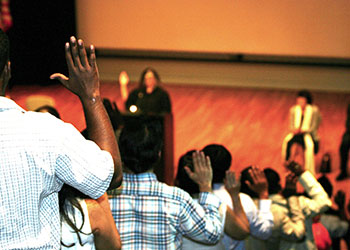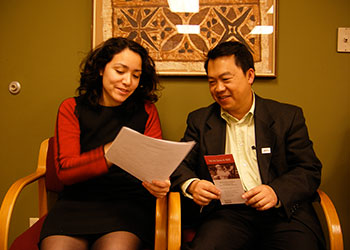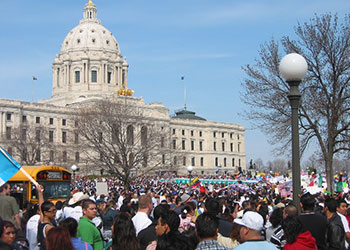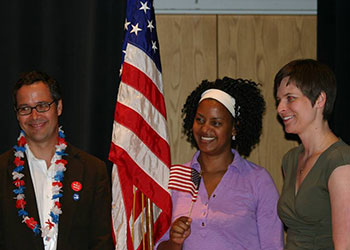Archives
Liberians in Minnesota have until December to start pursuing permanent U.S. citizenship. Some can’t believe the opportunity is real.
Jury awards $30,000 over Anoka County jail policy for foreign-born immigrants
Compassion, Commitment, and the Extra Mile: Isbely McKeen’s Work with Immigrant Women Survivors of Crime
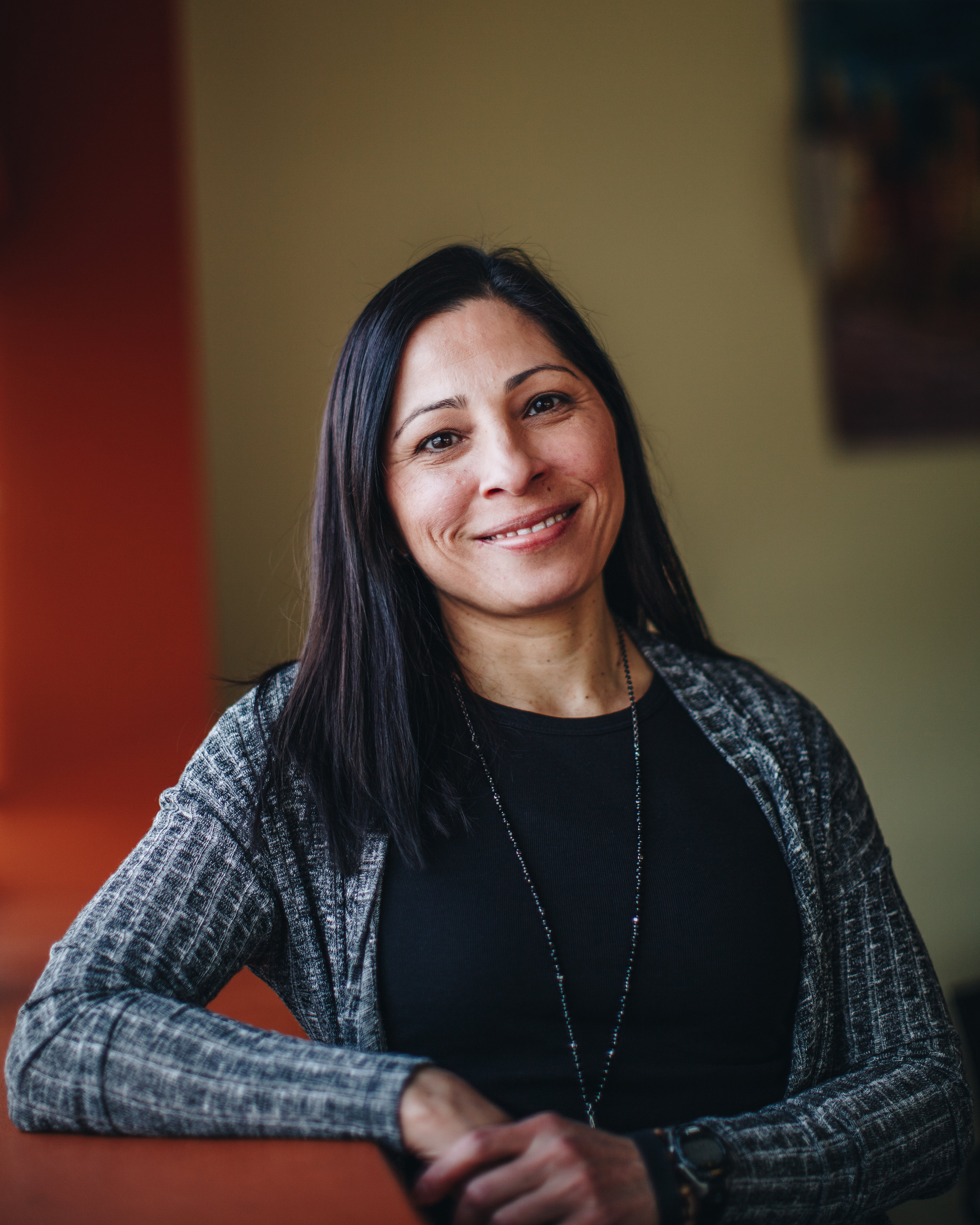
Congratulations to Isbely McKeen, winner of the Minnesota Alliance on Crime’s 2020 Spotlight Award for outstanding service to low–income clients!
Isbely works for the Immigrant Law Center of Minnesota (ILCM) as a Department of Justice Accredited Representative. The award especially acknowledges her work with ILCM’s New Beginnings program, which helps immigrants who are survivors of crime. Her work over the last five years has focused mainly on low–income women and children whose dreams of a better life in the United States have been impacted by domestic violence, sexual abuse, felonious assault, or human trafficking.
U.S. law protects all people in the country against crimes, even immigrants not officially recognized by the government. Isbely helps her clients leave abusive relationships and find resources to begin recovery by applying her legal expertise to help them work towards financial independence and U.S. citizenship.
“My clients have taught me that there are good people in this world, people who really do want to work.” Isbely says. “And even though they struggle, they are resilient; they really try, and they only need a hand to keep going and move forward.”
Isbely grew up in Venezuela, earned a law degree there, and worked with low-income clients before coming to the United States. She began an internship at ILCM in 2011 and later worked with Deferred Action for Childhood Arrivals (DACA) applicants and other immigration cases. In 2015, she earned a Department of Justice accreditation to advise and represent immigrant clients in certain situations.
Partly because of what she had seen in Venezuela, Isbely was drawn to the predicament of women who are survivors domestic violence or other crimes. In that situation, immigrant women here without legal documents can feel especially vulnerable and trapped. They may be financially dependent on their abuser, reluctant to go to local authorities for fear of being deported or of losing their children, or they may become isolated, fearing their abuser’s threats to punish or betray them if they try to leave or even talk to others.
Isbely says these clients usually need more than legal help. She helps them qualify for social services that can make it possible for them to leave their abuser, and she gives them hope that they can have a good life here in the future. Ultimately, she says her goal is to help them become financially independent and to gain legal status in the United States.
The Spotlight Award acknowledges her success at that goal, and she credits the support she has received in that work from her colleagues at ILCM. The work is “not easy,” Isbely says. “It’s not happy every day, but I like a challenge,” and she appreciates the good example set by her coworkers. When she first heard of the award, she says, “I was taken by surprise, because I felt like I’ve been awarded for doing my job. I really like what I do, and it feels good to get good news for our clients, so I’m like, okay, I love my work, and I get paid to do this, and then you give me an award — and this is my job?! All right!”
Isbely says that her passion to serve low–income clients came from her family during her childhood and from her ILCM colleagues now. She grew up in Venezuela among an extended family “with lots of aunts and uncles and more than one hundred cousins.” Like her mother, her aunts were homemakers for their families, while the men were in charge. “In a lot of Latin countries,” she says, “domestic violence is seen as just another event in everyday life.” Among her own family, she saw that relatives in abusive situations had “no advocates, no resources except the family dinner table. People would say ‘wake up, get out,’ but those were the only resources.”
As a teenager, Isbely brought an aunt to a series of attorneys to discuss her options. “They always started with questions about how much money you have, what can you pay, if it’s worth their time to help you,” she says. “They needed compassion. You shouldn’t have to have a lot of money to get out of a domestic situation.” Her extended family did not have a lot of money, Isbely says, but she is grateful that they encouraged the young people towards education. When the time came, Isbely applied to a law program at a Venezuelan university and graduated to practice law there with low–income clients. “I was always that kid who wanted to argue about something,” she says.
In those early years, Isbely met a U.S. citizen whose company had just posted him to Venezuela. She says they were married after “a short time of dating – don’t ask me how short. It was short.” A few years later, the couple left Venezuela when her husband returned to the United States. Their two children are now grown.
Isbely began at ILCM in 2011 with an internship gathering information from immigrant women victimized by crime and seeking legal help. She soon moved on to helping DACA immigrants with applications and certificates, and later working with a range of immigration cases in rural Minnesota. While doing that work, she noticed that some of her clients had experienced domestic violence. She knew that Congress had given some victims of violence a path to legal status in the United States.
In 2015, she joined the New Beginnings program and began working mainly with immigrant clients seeking relief from domestic violence, sexual assault, or trafficking. “Most people come here because they need a job, or they’re already running away from an abusive situation,” Isbely says. Her clients are usually women fleeing nightmare situations and lacking legal status in the United States. For basic safety, they have had to leave behind parents, siblings, and even children, hoping for a better life and a reunion before too long.
“You know, people always think that once you get here then you will have the dream come true,” Isbely says. “But that’s not necessarily true. I mean, our clients go through situations that are ....” Pause. “Our clients go through a lot of hardship and isolation, and it takes a long time to get adjusted to it.” Once here, many have “met someone with legal status and tried to create a family; but it hasn’t worked out,” so now they have young children and a relationship that has slipped into violence or other abuse.
The National Domestic Violence Hotline reports that domestic violence is no more common in immigrant communities than in non-immigrant communities. But for clients without legal papers, Isbely says, “isolation starts when a relationship goes wrong — and it is the family or the aggressor who isolates them by punishing them” or by refusing to help them gain legal status as a spouse.
She recalls a client “whose husband started to control her, keeping track of her whereabouts, asking her to switch or quit jobs, telling her how to dress, and finally he told her that she couldn’t have friends, that no one was welcome, using as an excuse that if they were men friends that they were in love with her and if they were girlfriends, they were telling her to rebel against him. He also installed cameras in the house to make sure she was complying with his requests.”
Isbely says women experiencing that kind of abuse, violence, or trafficking are often reluctant to call on the authorities for help, fearing that the police will ignore the perpetrator and create more trouble for the victim. One of Isbely’s colleagues explains the situation like this: “It is hard for most of us to imagine what it is like to be the victim of violence, and also an immigrant without documents, often unable to speak English, and trying to take care of children. That stress can come out in anger, panic, and depression. Isbely has dealt with all that with unfailing compassion.”
For these clients, Isbely says, “Their illegal status is always in their heads. It’s the idea of being wrong, of being illegitimate, and that’s why they don’t run out of a situation: because they find protection from deportation in their aggressor and there’s always that manipulation about their legal status, because if you don’t have legal status the police will take away your children. It’s like a chain.” Isbely works to break the chain.
Some of her clients have already managed to leave a bad situation, but are now struggling to support themselves and bring up children. “We Hispanic people are very social,” Isbely says, “and when we come here, we do not leave our culture and traditions behind.” Her clients “look for jobs where they can speak Spanish and be with people who have the same traditions.” For a lot of women trying to work and raise children alone, “their co-workers become their network,” Isbely says, and though they support each other with advice, loans, babysitting, and rides, they might still need outside help.
Isbely helps them gain special refugee visas available to victims of domestic violence, sexual abuse, or trafficking. This would allow them to get work permits, putting them in the way of better pay and more secure employment, and making them more financially independent. And if the pay is not enough, with the visa they might qualify for assistance with food, rent and medical expenses, cutting their financial ties to the abusive partner.
Ultimately, Isbely’s goal is to set her clients on a path to citizenship. Many of them have already been in the United States for 10 years or more without papers. In her first meeting with them, she wants “to give them hope that there is something for them here in the future, whereas now they are in limbo; they are afraid; they don’t know if they can get legal status any time soon. So making them know that they can have a life here and aspire to legal status, that’s my main goal. When I see them before me empty-handed, and when we could give them a little bit of hope, I’m like, yeah, I can do this; I can go the extra mile for this person.”
Isbely says her colleagues at ILCM have shown her that there always seems to be another extra mile one can go. With these survivors of crime, she says, “I can recognize where the need is, because I grew up seeing that.” When she first came to ILCM, it also “helped to see how compassionate my co-workers are. On a case when I thought I had done enough, they would come and say, ‘Well, could you do this or that?’ and I would think, hmm, yes, I could do that.
“So now when I look at a case, I turn it upside down and then turn it right side up again until I can see that, yeah, we can do this. And it actually gives me hope then, when the client smiles, and I think, ‘Okay, this is going to work out.’” And it usually does work out. One of Isbely’s colleagues says, “Thanks to her efforts, virtually all of her clients have been approved – won legal status in the United States. Someone must have been denied, but to be honest, no name comes to mind.”
Isbely is not the only person at ILCM working with crime victims, though it is her specialty and her passionate commitment. “Once I grab a case,” she says, “I think it’s mine.”
Years ago, she worked in the for-profit legal sector, and has since adjusted to the more limited resources available in non-profits like ILCM. “Anything you can put in front of me that I can use to help my clients, believe me, I use it. Nothing goes to waste.” And she understands that her clients need more than the legal help she provides. “If they need therapy, counseling, money for rent, I try to be aware of that and look everywhere for resources.”
Asked if she enjoys challenges, Isbely suddenly bends so far forward in her chair that she disappears from the Zoom window. She rises three seconds later with a huge smile and quietly replies, “Yes, I do like a challenge.”
She says the most difficult part of her work is “detaching.” If she can see that a client is in need and the case is difficult, she says, “I don’t think about the hours it will take; I will work on Saturdays; I will do whatever it takes.” She mentions burnout, but does not worry about it.
“I felt lucky from the beginning when I came to ILCM and fell in love with the work. And my co-workers are excellent. Sometimes I feel guilty because my compassion for clients and passion for this work are maybe not as great as theirs. But they have taught me a lot.
“I really like what I do. ILCM is a great organization; it has great values, great morals, and great support. And my clients,” she says, “you have to see their faces, hear their voices,” when she gives them good news. “I’m fortunate that God put me in their way to help them move forward. We make a great team. They accept my help, and I like getting good results for them. So I’m happy where I am.”
_____
ILCM Testimony in Support of Certifications for Victims of Crimes
January 26, 2021
RE: HF (TBD) Certifications for Victims of Crimes
Dear Chair Mariani and members of the Public Safety and Criminal Justice Reform and Finance Policy Committee:
The Immigrant Law Center of Minnesota (ILCM) strongly supports the proposed bill HF (TBD) Certifications for Victims of Crimes. We respectfully request that members of this committee support efforts to prevent the victimization of Minnesota residents, especially in Greater Minnesota.
ILCM operates five offices across the state of Minnesota to provide comprehensive, free legal representation to immigrant communities, as well as education and advocacy support. Our Greater Minnesota offices include locations in Worthington, Austin, and Moorhead. In 2019, 40% of the clients we served resided in rural Minnesota.
The New Beginnings Project at ILCM assists immigrant victims of violence and their children to obtain legal status through cooperation with law enforcement, thereby gaining the independence needed to escape a cycle of violence. As one of the largest legal projects operating at ILCM, New Beginnings represents crime victims and victims of domestic violence. ILCM coordinates closely with our community partners to provide safety planning services and support for survivors during this difficult period in their lives.
Congress enacted U visa legislation to improve safety within our communities by encouraging the victim’s cooperation with law enforcement and providing immigration protection to the victim and their children.
Our primary role is assisting many of these vulnerable immigrants and their families in applying for legal status. Legal status, when awarded, lifts these victims and their families out of crisis and empowers them to obtain self-sufficiency and stability without fear of having their status exposed. With U visa status, they can rebuild their lives.
Our attorneys work hard to best serve our clients. This legislation would provide greater efficiency in the first step of the process: gaining U visa certification. Only with this certification can the immigration case continue.
At present, Minnesota lacks a standard certification process for the U visa. Attorneys and survivors work in partnership with law enforcement agencies to forge relationships beneficial for all parties involved. As victims of violent crime without lawful immigration status, U visa applicants open themselves up to law enforcement partners in order to enhance their own safety,
as well as the safety of the entire community. However, our ILCM attorneys constantly face new obstacles when they encounter different systems and timelines at each agency throughout the state. A streamlined process proposed in this bill will not only allow our attorneys to better advocate for our clients, but also allow us to participate as better partners to law enforcement. The communities we serve, and the entire state, will benefit through enhanced efficiency and effectiveness of the U visa process.
Congress intended to protect all immigrant victims of violent crimes as well as improving public safety and law enforcement systems. Our clients present horrific accounts of domestic violence, sexual assault, violent physical assault, being held hostage or criminally restrained, and more. Immigrant survivors of violent crimes rely on this U visa process in order to pursue justice through our criminal system. Every obstacle faced in the first few months affects when and how the rebuilding process happens for these victims. A survivor of domestic violence cannot wait a prolonged period for the certification process as she starts her life anew. A survivor of sexual assault desperately needs a quick process to protect her immigration status as she attempts to rebuild trust with her surroundings after an attack.
Law enforcement needs the quick and complete cooperation of victims of violent crime. Those victims need and deserve the protection offered by Congress in the U visa program.
This bill will directly uplift survivors of violence in all communities during an incredibly difficult period of their lives. It will improve the work of ILCM and attorneys across the state who partner with law enforcement agencies on behalf of their clients. Finally and most notably, this bill will provide guidance and support for law enforcement agencies to comply with the U visa process set forth by Congress.
We respectfully ask for your support for this important and necessary legislation.
Sincerely,
Veena A. Iyer, Executive Director
Immigrant Law Center of Minnesota
Tell Congress: Act Now for Pathway to Citizenship
On January 20, Joe Biden was inaugurated as the 46th President of the United States. Within hours, he signed six executive orders reversing anti-immigrant policies, and announced he would send to Congress a bill that would modernize our immigration system, prioritize keeping families together, and create a pathway to citizenship for undocumented immigrants, and an accelerated path for DACA recipients, TPS recipients, and farmworkers.
Now, it’s our job to make sure that promises become reality and proposals become law.
Call your Senators. Call your Congressional Representative: Tell them that immigration is a high priority and that you want them to vigorously support the U.S. Citizenship Act of 2021.
January 2021 Staff Updates

ILCM is excited to welcome 19 new interns, volunteers, and team members! Among them:
Femi Akindumila is a Capitol Pathways intern who will be working with our Executive Director Veena Iyer on advocacy this spring semester. Femi is a junior at the University of Minnesota and grew up in Brooklyn Center.
Josie Allaire starts her AmeriCorps VISTA term of service on January 19th as an Outreach Coordinator for the Austin Area Minority Business Project. She graduated from the University of Minnesota in 2019 with a degree in Global Studies and Public Health. Josie spent her first year out of college working as an ELL Assistant and French Teacher. This past fall, she worked as an Emergency Response MOC for the International Institute of Minnesota as a Student Technology Coordinator.

Paola Irazoque, who is joining us as a part-time receptionist. Paola graduated from St. Catherine’s with a degree in social work and has a lot of experience working in social services, including at CLUES.
The ILCM Board also elected two new board members.
Andrea Valdez Correa is a former ILCM client. She is a recent graduate of Hamline University and has done academic work and volunteer work supporting immigrants.
Fred Bw’Ombongi is the Vice President of Access Management for Allina Health. He previously worked in health care in Kentucky and Michigan. He started his work in the United States in Grand Rapids, Michigan, where he was a refugee case worker for a Catholic Charities- funded organization and later started an immigrant and refugee services organization. Fred is an immigrant from Kenya.
 We also continue our search for a receptionist, a finance and development manager, and a development associate to join our team. For more information or to apply, please visit our Careers page.
We also continue our search for a receptionist, a finance and development manager, and a development associate to join our team. For more information or to apply, please visit our Careers page.
ILCM also said goodbye to Melissa Pfeiffer, Maggiy Emery, and Shenelly Perez-Beltran. We wish them the best on their next adventures.
Biden Administration’s January 20 Executive Actions on Immigration
Summaries of the key January 20 executive actions affecting immigration.
In D.C., a mob tried to overturn multiracial democracy. In St. Paul, the most diverse Minnesota legislature ever is just getting started.
“Since 2014, the number of legislators of color in the Minnesota Capitol has more than tripled, from 8 to 25. That means people of color represent 12 percent of the legislature, while people of color make up some 20 percent of the Minnesota population….
“At a moment when democracy seems especially fragile, Minnesota’s legislators of color plan to strengthen it by bringing in voices that often don’t get heard in the political process….
“‘I think where we put our money shows what we actually value,’ [Newly-elected MN Representative Esther Agbaje] said. ‘I’m hoping to be a voice on those committees to make sure that we’re putting our values towards people, and putting our money and resources to value the people we haven’t really in the past.’”
A Very Good Beginning – President Biden’s First Day Immigration Actions
January 21, 2021—Yesterday evening, President Biden signed six executive orders directly relating to U.S. immigration laws. These executive actions reverse the Trump Administration’s 2020 U.S. Census executive order, end the Muslim travel bans, rescind the 2017 interior enforcement executive action, stop of the U.S.-Mexico border wall construction, renew the Liberian Deferred Enforced Departure (DED) program, and strengthen the Deferred Action for Childhood Arrivals (DACA) program. The new Biden administration also issued a moratorium on deportations and suspended the “Remain in Mexico” bars to asylum seekers.
“President Biden’s first-day actions signal a commitment to reverse the racist and xenophobic policies of the previous administration,” said Veena Iyer, executive director of the Immigrant Law Center of Minnesota (ILCM). “We look forward to an administration that understands and values the contributions and inherent humanity of immigrants and refugees in the United States.”
President Biden also sent sweeping immigration legislation to Congress today. The U.S. Citizenship Act of 2021 establishes paths to citizenship for Dreamers, individuals with Temporary Protected Status, immigrant farmworkers, and undocumented immigrants living in the United States before January 1, 2021. The legislation expands protections for refugees and asylum seekers and promotes family reunification. It also strengthens protections for crime victims and victims of human trafficking and begins the much-needed process of improving the immigration court system.
“Biden’s first-day actions signal a very good start, but only a start,” said Iyer “During the months ahead, we face the hard work of making sure that a deeply divided Congress comes together and passes the U.S. Citizenship Act of 2021 and that immigration agencies and courts are repaired and reformed.”
